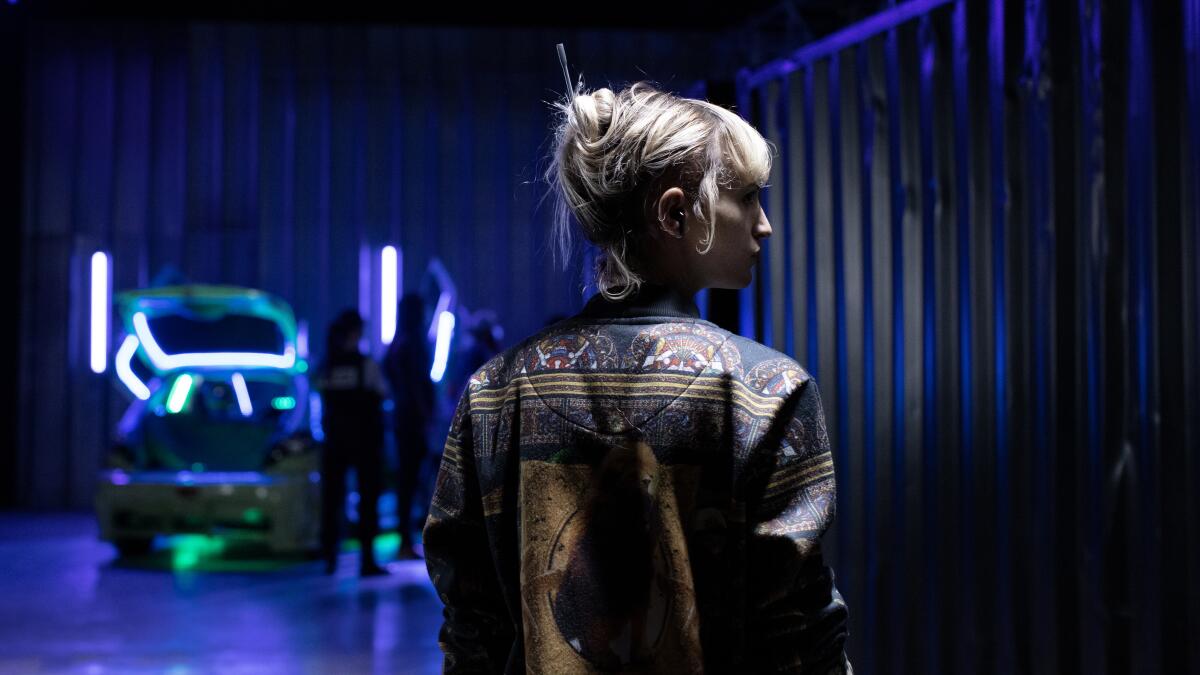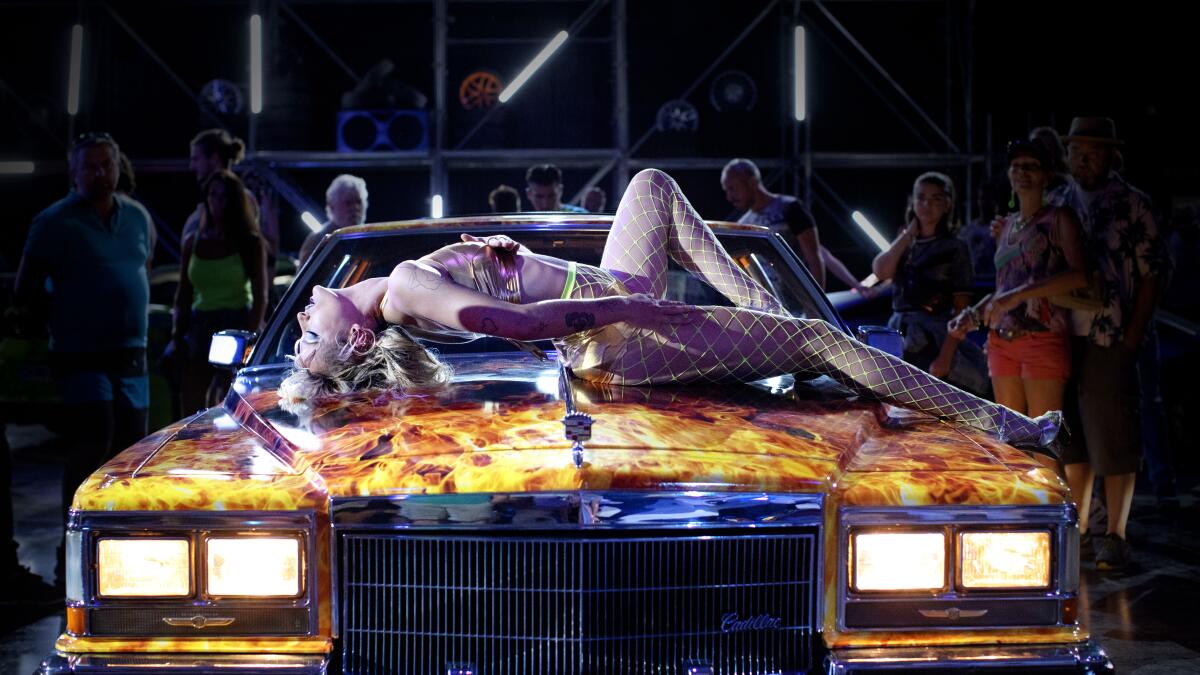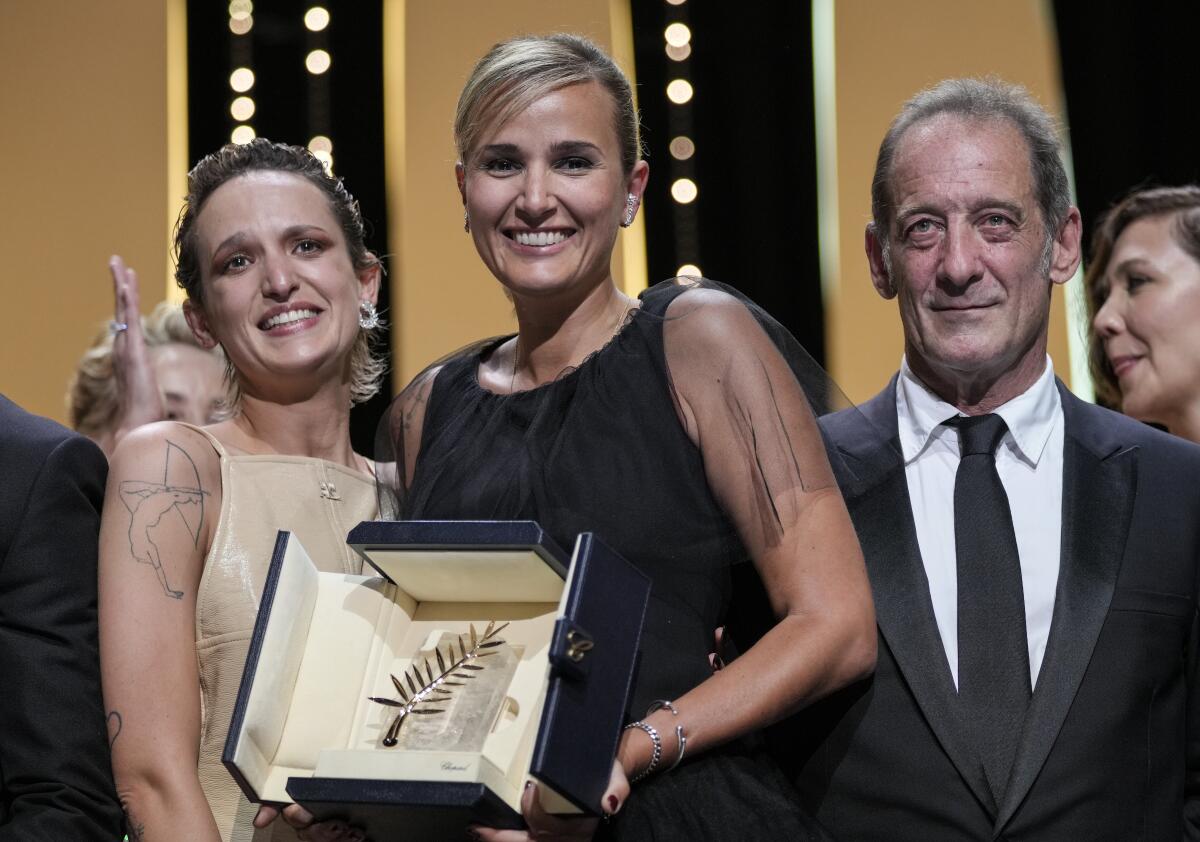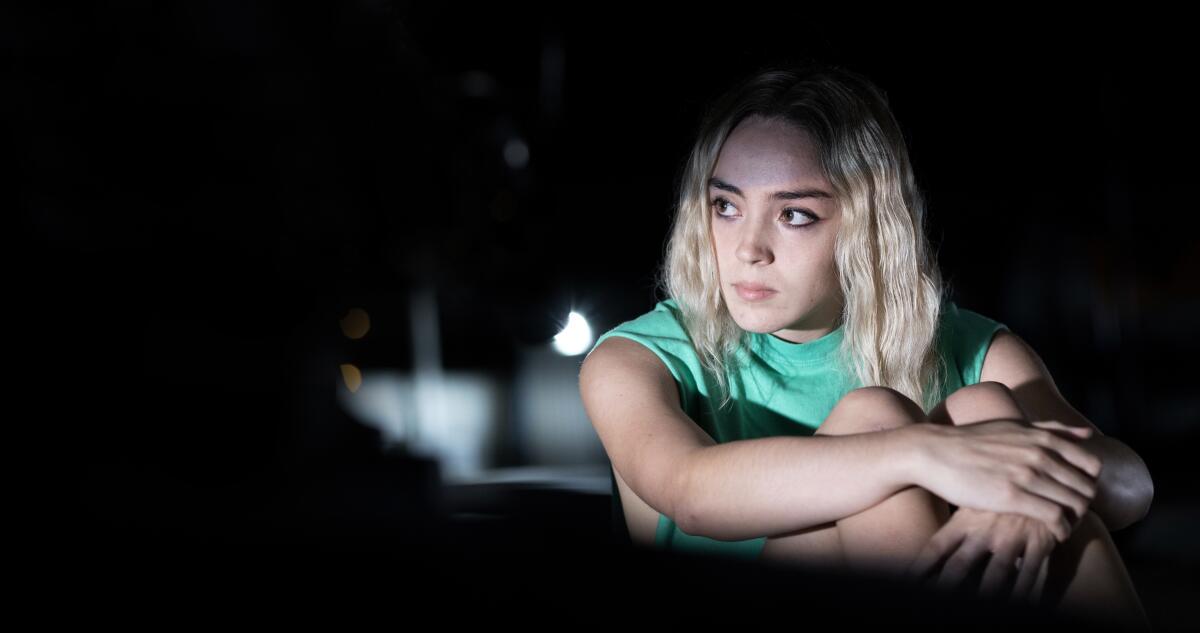‘Titane’ director Julia Ducournau explains how she crafted the year’s wildest film

- Share via
The work of French filmmaker Julia Ducournau feels wholly singular, like a world unto itself.
Her latest, “Titane,” is a hallucinatory journey to the heart of identity and the transformative power of love. It took the top prize at this year’s Cannes Film Festival, becoming only the second film directed by a woman in the more than 70-year history of the festival to win the Palme d’Or.
The film, now playing nationwide from Neon Films, follows the wild journey of Alexia (Agathe Rousselle), a dancer at car shows who has a titanium plate in her head from a car accident when she was a child and a vivid scar to show for it. One night, when a fan gets forceful with her in a deserted parking lot, she embarks on a series of homicides and goes on the run. She assumes the identity of Adrien, the long-missing son of a firefighter, Vincent (Vincent Lindon), who is so overwhelmed at the return of his child that he overlooks any discrepancies, such as Alexia’s increasingly difficult-to-hide pregnancy.
While Ducournau’s film is at times shocking and unnerving, the truest surprise of “Titane” is the tenderness that emerges between Alexia and Vincent, as the loneliness and isolation they have both felt for so long melts away, reforged as empathy and belonging.
Many have compared “Titane” to David Cronenberg’s “Crash,” which caused a sensation at the 1996 Cannes festival for its own conflation of sex, violence and cars, but Ducournau says that wasn’t one of her primary influences. Rather, she sought inspiration from painting and photography and draws formal and thematic connections to Sam Mendes’ 2019 movie “1917” and John McNaughton’s 1986 film “Henry: Portrait of a Serial Killer.”
At the Cannes awards ceremony this past summer, jury president Spike Lee accidentally announced “Titane” as the winner at the beginning of the event, and Ducournau spent the entire evening waiting for official confirmation. But she was still able to recognize the historic nature of her victory.
“I remember there was something going through me ... that felt way beyond me,” Ducournau said. “When [presenter Sharon Stone] asked me how I felt, I said, ‘It feels like history.’ And she laughed, with this very bright smile, and she said, “Honey, this is history.’ It felt good that she said that because I had the feeling that I was propelled into the future somehow ... .
“[Jane Campion] could have felt like she was an exception,” said Ducournau of the only previous female Palme d’Or winner, who won for 1993’s “The Piano.” “And indeed unfortunately ... we had to wait 28 years before the next one. But me being the second one, it was impossible to say it’s an exception. It was just the start of something. So I thought about the third one, the fourth one, the fifth one. And I was like, ‘OK, we’re not alone in that. And I’m indeed with the next ones. I’m propelled into the future.’”

GENRE EXPECTATIONS
Along with upscale festivals in Cannes, Toronto and New York, the film also is playing at audience-oriented genre festivals like Fantastic Fest and Beyond Fest. Do you consider yourself a genre filmmaker?
Julia Ducournau: I use the grammar of body horror for sure. I like to divert the codes of horror, to divert the expectations of the audience. A lot. Like all of a sudden you can have tension appearing from an apparently domestic situation or a strangeness appearing from the domestic situation and the reverse. You can also have comedy emerging from a very horrific situation. And also obviously, I like emotions coming at the end of my film — real emotion that you don’t expect when you see the beginning of it. I really like to play with all those codes and to disrupt them, divert them and intertwine them.
So I consider definitely myself as a genre filmmaker, but I would like to say genres, plural. For me, it’s really about playing with all the tools and all the codes that are at my disposal, in the spectrum of human psyche and human emotions, and try to somehow bend them all together.
Regardless of everything else that happens to her, the character of Alexia is still a serial killer. How much do you want audiences to sympathize or identify with her as she’s going through everything else in the film?
That’s one of the big, big challenges that I had when I was writing. ... I knew from the start that I would have a film [that] would follow a character, who’s presented as the main character, and that it was impossible to like her, to morally relate to the person. How do you do it so that the audience doesn’t get out of the room after three minutes or five minutes because they just don’t have a stomach for it? And so I thought, is there only one way to relate to a character?
Do we really have to have main characters that are morally acceptable to us? I obviously do not think so; that would be incredibly reductive. There have been many more examples in the history of cinema that prove this wrong. I’m thinking, for example, about “Henry: Portrait of a Serial Killer.” It is incredibly remarkable in the way it bends the audience’s morals, especially compared to this other fellow, Otis. Henry is a horrible character, a serial killer, and he doesn’t have any empathy whatsoever, but compared to Otis’ relationship with his own sister, you root for Henry when he says, “Don’t touch her.” And all of a sudden, as an audience, your morals are completely twisted. You feel empathy for Henry at this moment when you actually were horrified by him from the start. I think that’s brilliant.
For me, what I thought is that if the audience can’t relate morally to her then I’m going to make them relate to her body. And her body was my entry point to create an umbilical cord between the audience and her, because I thought, “they’re going to feel what she feels.” That creates a bond because at one point, for example, when she has the whole killing spree in the house and stuff, you really feel her fatigue. “It’s too tiring, it’s too much, this situation is too grotesque, let’s finish it.” And I like doing that. It’s the first time that you can actually bond with her. That was a very conscious strategy for me that I thought about while writing but had to really deliver with the direction.
Do you consider the movie in any way a fairy tale? Is all of what we see real within the world of the movie or does any of it exist only in Alexia’s head?
Of course it’s real. That’s the world I created and these are the rules of the world I create. Everything is real. There is no dream sequence in my film.

VISUAL REFERENCES
Were there any specific films or filmmakers that you were drawing from as you were conceiving of the movie?
No. When I write, and also when I direct, I don’t watch films on purpose, because I think it’s important to try to stick to your own tracks and to be precise in it and be demanding with yourself and try to go deeper and deeper. So no, I don’t think about other movies, although I am obviously incredibly aware of the “Crash,” comparison. I knew already when I was writing that this was going to happen, but at the same time, it’s so different; it’s not even the same POV and not the same energy, and that’s not even the same intention. Obviously, Cronenberg is someone who journalists will always ask me about because of how foundational it has been for me in my life. And it will always be. But at the same time you can’t make a good scene by trying to mimic someone else’s scene.
So the influences for me, they come in handy just technically. My DP [Ruben Impens] would be the person I would talk [to] about them the most, for details or a certain scene. For example, with the forest scene, [when Vincent is nearly engulfed by a forest fire] I knew I wanted a very artificial light to it. And we both had just seen “1917,” which is, like, outstanding in terms of technique. It’s amazing, the lights and the camera movements in this. I love this film. And so we decided to go for something very artificial, like the city that is burning in “1917.”
That was a very specific reference, but otherwise it’s small things. I think my influence comes a lot from art, I told Ruben at the start there was something I wanted, something that was very dark and very contrasted, because I wanted to see lights protruding from darkness. And so immediately we gathered around Caravaggio’s work and we talked about it, we examined some paintings. I showed him “The Empire of Light” by Magritte as well as “Summer Night” by Winslow Homer, which was actually a direct reference for the shot where she’s throwing up in the sea at the beginning.
You’ve spoken before about the influence of the photographer Nan Goldin. How does the influence of something like that manifest itself in the movie?
It’s never a direct influence in the sense that I’m not trying to replicate some of her photographs, but it’s true I see her photographs as incredibly organic, which is something that I always liked because I’m very obsessed with portraying the triviality of bodies. And I think she’s a master in that, really. I love her effort in trying to grasp the beauty in things and people and situations that people would normally qualify as being marginal or repulsive or ugly. And she always, always goes deeper and tries to shed the layers of representations and social constructs and tries to get beauty out of that. Again, that’s something that I’m trying to do in my work. So in that she’s a major influence for sure.

CASTING
Agathe Rousselle had never acted before you cast her in the lead role. How did you find her?
My casting director found her on Instagram because I’m not on social media. It was very clear from the start that I was going to work with nonprofessionals for this particular part, because I did not want anyone to project anything on that exact transformation. I wanted everyone to accept every stage of that transformation without thinking, “Oh, that’s this actress I saw in a film when she was very feminine and on high heels and now she’s in disguise.” I really did not want the audience to think about a disguise. I wanted them to accept it like the truth of the characters and that every time you shed a layer and you get moved through another transformation, it’s a new truth of the character.
I really needed a face that was completely unknown. And obviously that was very androgynous. I tested male and female nonprofessionals, and it was a long [process] because it was very broad. In the end I made her come back like five or six times because we’re talking about people who had never acted before, so you really have to dig deeper. After that we worked for a year or so based on both her acting and physical preparation; she didn’t know how to fight, for example, and Alexia is someone that at least has to feel threatening if you’re in front of her.
I made her work on monologues from many films and one series, “Killing Eve”; Villanelle [played by Jodie Comer] is kind of close in some ways. And I made her work on Sidney Lumet’s “Network” — “I’m mad as hell and I’m not gonna take it anymore” — because it’s a big spectrum of emotions. He goes from really like a sarcastic defense to a complete utter madness, anger and ends on very big despair.
I wanted to see what she was capable of — what kind of emotions she was capable of and what I could get out of her and what her limitations were. I need to have a grasp of all that before the shoot.
That sounds like so much work to get that performance from her. What was it about her in particular that made you want to begin that process?
It’s a mix of things. You can never be sure. We were taking a huge bet at one point when you choose someone among other nonprofessionals. Various factors come into consideration; it’s not just the acting. She had the perfect look. So I wanted to film her. That she triggered this in me is already a very good thing, because instinct, that’s a very important thing.
[And] she could not really act at that moment, but somehow I liked her style, I liked her posture, I liked the way she moved, which is very important for me. And especially on a silent character. Casting nonprofessionals is a very different exercise.
Did you cast Garance Marillier, the lead actress from “Raw,” in a small role as a nod to fans of your first film?
It’s not for fans; it’s for me. Garance is like my little sister in real life. So she will always be in my films. I feel like no matter if it’s a main part or a secondary part or whatever, she’s too important to me. She’s part of my life and of my cinematic universe.
More to Read
Only good movies
Get the Indie Focus newsletter, Mark Olsen's weekly guide to the world of cinema.
You may occasionally receive promotional content from the Los Angeles Times.











